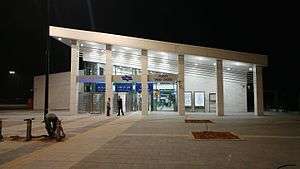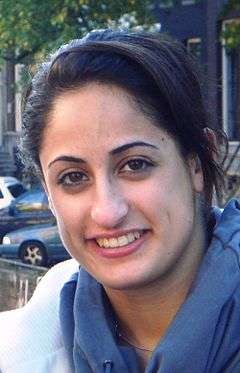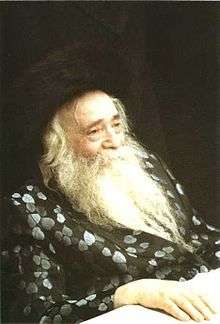Netanya
Netanya
| |||
|---|---|---|---|
| Hebrew transcription(s) | |||
| • ISO 259 | Netanya | ||
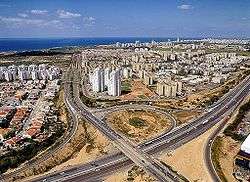 View of South Netanya from Poleg neighbourhood | |||
| |||
 Netanya Location within Israel | |||
| Coordinates: 32°20′0″N 34°51′0″E / 32.33333°N 34.85000°ECoordinates: 32°20′0″N 34°51′0″E / 32.33333°N 34.85000°E | |||
| Country |
| ||
| District | Central | ||
| Founded | February 18, 1929 | ||
| Government | |||
| • Type | City | ||
| • Mayor | Miriam Feirberg Ikar | ||
| Area | |||
| • Total | 28,455 dunams (28.455 km2 or 10.987 sq mi) | ||
| Population (2017)[1] | |||
| • Total | 214,101 | ||
| • Density | 7,500/km2 (19,000/sq mi) | ||
| Name meaning | God gave | ||
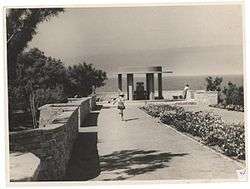
Netanya (Hebrew: נְתַנְיָה, lit., "God gave"; Arabic: نتانيا) is a city in the Northern Central District of Israel, and is the capital of the surrounding Sharon plain. It is 30 km (18.64 mi) north of Tel Aviv, and 56 km (34.80 mi) south of Haifa, between the 'Poleg' stream and Wingate Institute in the south and the 'Avichail' stream in the north. Netanya was named in honor of Nathan Straus of Macy's, a prominent Jewish American merchant and philanthropist in the early 20th century.
Its 14 kilometres (8.7 mi) of beaches have made the city a popular tourist resort. In addition, the city is known for its large immigrant population. A significant percentage of the city's population consists of immigrants from the former Soviet Union, France, and Ethiopia, and the city is home to a notably large population of English-speaking immigrants from the United Kingdom, United States, Canada, South Africa, Australia and New Zealand.
In 2017, it had a population of 214,101,[1] making it the 7th largest city in Israel. An additional 150,000 people live in the local and regional councils within 10 kilometres (6 miles) of Netanya which serves as a regional center for them. The city mayor is Miriam Feirberg.
History

The idea to create the settlement of Netanya was drawn up at a meeting of the Bnei Binyamin association in Zikhron Ya'akov.[2] The location was decided upon near the ancient site of Poleg, and it was decided to name it in honor of Nathan (Hebrew: Natan) Straus (1848–1931),[3][4] co-owner of Macy's department store,[5] New York City Parks Commissioner, and president of the New York City Board of Health,[6] who gifted two-thirds of his personal fortune to projects benefiting Jews and Arabs in Palestine.[4][6][7] "Netanya...was named for Straus in the hope he would donate money to them. When he told them he had no more money to give they were disappointed, but decided to keep the city's name anyway."[8] In 1928 members of Bnei Binyamin and Hanote, an organisation set up after Straus was informed of the establishment of the settlement, purchased 350 acres (1.4 km2) of Umm Khaled lands.[2]

On December 14, 1928 a team led by Moshe Shaked began digging for water at the site, finding it in February 1929. Subsequently, on February 18, 1929, the first five settlers moved onto the land, plowing and cultivating it for the first time. In the weeks that followed, more settlers began arriving. The land was divided between the settlers in June 1929 as slowly the vision of the settlement became reality. Development was set back, however when the 1929 Palestine riots and massacre of Jews caused the settlement to be abandoned for a couple of weeks. By September, however, development was back on track with the cornerstones for the first 10 houses being laid on Sukkot.[2]

In the following years, Netanya continued to grow, with the first kindergarten and shop opening in 1930, and the first school in 1931. In the 1931 census of Palestine, Netanya was recorded as having 253 residents. In 1933, the British architect Cliff Holliday proposed a plan for Netanya to become a tourist city. Holliday also prepared urban projects in Jaffa, Tiberias, Lydda and Ramla.[9] The first urban plan for the city, saw it being divided into three sections with a tourism district along the coastline, housing, farms and commerce in the center, and agriculture and industry to the east. That year also saw the completion of the Tel Aviv Hotel, the first hotel in Netanya, as well as the establishment of two new neighborhoods, Ben Zion and Geva.[2]
The moshava as it then was continued to grow in 1934, when the first ship of illegal immigrants carried 350 to Netanya's shoreline. These operations continued until 1939, with over seventeen ships landing near the city, being aided by the residents of Netanya. Whilst flourishing agriculturally, 1934 also saw the city diversify with Primazon opening the first factory there, producing fruit and vegetable preserves. Following this, the first industrial zone was set up, whilst the Shone Halahot Synagogue was built and the Bialik School inaugurated.[2]
As the settlement continued to grow, 1937 saw a cornerstone laid for a new commercial center and the connection of Netanya to the Tel Aviv-Haifa road. In 1940, the British Mandate government defined Netanya as a local council of which Oved Ben-Ami was elected head of.[2] Expansion continued after this point. In 1944, Netanya had a population of 4,900. The first high school in Netanya opened in 1945.
_IN_NETANYA._%D7%A8%D7%97%D7%95%D7%91_%D7%94%D7%A8%D7%A6%D7%9C_%D7%91%D7%A0%D7%AA%D7%A0%D7%99%D7%94.D25-063.jpg)
During the Jewish insurgency in Palestine, the Jewish underground group Irgun launched a number of attacks against British military and police forces in the Netanya area. The town itself was a bastion of support for the Irgun. The most infamous incident happened in July 1947, in what became known as the Sergeants affair. After three Irgun fighters had been sentenced to death by the British, the Irgun abducted two British sergeants on a Netanya street, and hid them in an abandoned factory. The British responded by declaring martial law and placing Netanya and the surrounding area under curfew. The British Army searched the town and interrogated residents, but did not find the sergeants. After the three Irgun fighters were hanged, the Irgun hanged the two sergeants in the factory and re-hanged and booby trapped their bodies in an orange grove.[10]
In November 1947, an Egged bus which left Netanya for Jerusalem was attacked in Petah Tikva. In 1948, following the withdrawal of British forces from Netanya and the 1948 Arab-Israeli War, a large military base was established in the city. On December 3, 1948, after fighting in the area had calmed down, Netanya was designated a city, the first city to be designated in the newly established State of Israel.[2] A number of nearby settlements, Ramat Tiomkin, Ein Hatchlelet, Pardes Hagdud, and Ramat Ephraim, were annexed to Netanya. At this time, Netanya had a population of 11,600.[11] In 1949, the Kiryat Eliezer Kaplan Industrial Zone was inaugurated and the nearby settlement of Neve Itamar, which had been founded in 1944, was annexed to Netanya.[12][13]
The city continued to develop in the following years as many Jewish immigrants settled there. Netanya railway station was opened in 1953. The population reached 31,000 in 1955. To accommodate the large number of new immigrants, the Israeli Housing Ministry built large numbers of housing units with dwelling spaces of about 50 square meters.[11] The cornerstone of the Kiryat Sanz neighborhood, which was to house religious residents, was laid in 1956. The first stock exchange built in Israel was built in Netanya.[2] By 1961, the city's population had grown to 41,300.
Netanya continued to grow throughout the 1960s. During the Six-Day War in 1967, Netanya was hit by Jordanian artillery, and Jordanian planes made sorties near Netanya, but failed to cause major damage. A lone Iraqi bomber attacked Netanya, dropping several bombs which damaged a factory and caused some casualties, shortly before being shot down.
Netanya had a population of 71,100 in 1972. Laniado Hospital opened its doors in 1975, starting with an outpatient clinic, and gradually expanding throughout the following years. The population had grown to 102,300 in 1983. Two master plans for the city, released in 1982 and 1985 respectively, saw the new standard apartment size increase to a minimum of 100 square meters. Hotel development along the coast was further advanced, and tourism gradually increased. At its peak in the 1980s, Netanya accounted for 10% of national tourism. This, together with its thriving diamond industry, led it to be known as the "tourism and diamond city." Tourism would later slow down after the diamond industry moved away and government budgets would focus on developing other areas for tourism.
In the 1990s, large numbers of immigrants from the former Soviet Union settled in Netanya, greatly expanding the city's population and resulting in large-scale housing construction.[11]
Netanya suffered from several Palestinian bombings during the Second Intifada, including the Netanya Market bombing and, in the same month, the Passover massacre which caused the death of 29 people.[14] Such attacks were cited as justification for the construction of the Israeli West Bank barrier which has proved effective in stemming suicide attacks.[15]
Following increased immigration by French Jews to Israel in the 2000s and 2010s, Netanya became one of their primary destinations. Thousands of French immigrants settled in Netanya, which influenced the local culture.[16]
Demographics
| Historical population | ||
|---|---|---|
| Year | Pop. | ±% p.a. |
| 1929 | 5 | — |
| 1931 | 100 | +347.21% |
| 1948 | 11,600 | +32.26% |
| 1955 | 31,000 | +15.08% |
| 1961 | 41,300 | +4.90% |
| 1972 | 71,100 | +5.06% |
| 1983 | 102,300 | +3.36% |
| 1995 | 146,100 | +3.01% |
| 2008 | 179,000 | +1.57% |
| 2012 | 192,200 | +1.79% |
| 2015 | 207,946 | +2.66% |
| [2][17] | ||
In 2017 Netanya was home to 214,101. The population density of the city is 7,115 per square kilometer.[17] The population is expected to be around 320,000 in 2035.[18] According to a 2001 survey by the CBS, 99.9% of the population are Jewish and other non-Arabs. In 2001 alone, the city became home to 1,546 immigrants. According to CBS, in 2001 there were 78,800 males and 84,900 females with the population of the city being spread out with 31.1% 19 years of age or younger, 15.3% between 20 and 29, 17.2% between 30 and 44, 17.4% from 45 to 59, 4.2% from 60 to 64, and 14.9% 65 years of age or older.
In terms of the origin of Netanya's residents, 63,800 originate from Europe and America, 30,200 from North Africa, 18,100 from Asia, 10,500 from Ethiopia and 38,100 from Israel in 2008. That same year, 90,200 of the residents of Netanya were born in Israel, whilst 71,300 were born abroad.[19] A significant number of Ethiopian Jews in Israel have settled in Netanya with over 10,500 Ethiopian Jewish residents in the city.[20] Netanya is also the center of the Persian Jewish community of Israel.
As of 2000, the city had 58,897 salaried workers and 4,671 self-employed with the mean monthly wage in 2000 for a salaried worker in the city being NIS 4,905, a real change of 8.6% over the course of 2000. Salaried males have a mean monthly wage of NIS 6,217 (a real change of 9.0%) versus NIS 3,603 for females (a real change of 6.8%). The mean income for the self-employed is 6,379. There are 3,293 people who receive unemployment benefits and 14,963 people who receive an income guarantee.
In terms of religion, Netanya is made up approximately of 50% secular Jews. It is also the home of the Sanzer Hasidic dynasty, as well as a large Chabad Lubavitch presence.
Economy
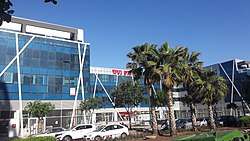
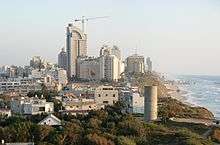

Industry in Netanya is largely divided between four industrial parks. In the south of the city, the newest of these, Poleg, houses the first branch of IKEA in Israel as well as many technology companies, such as Ceedo and LogiTag. Tourism also plays a fairly major part in Netanya's economy with some 19 hotels in the city having 1,452 rooms. On average, this creates some 589 jobs. The hotels had an average occupancy rate of 51.7% in 2006. Netanya's long seashore and many beaches have created a holiday industry, which in turn features resort hotels, restaurants, and malls.
Geography
Netanya is located on the Israeli Mediterranean Coastal Plain, the historic land bridge between Europe, Africa, and Asia. The city is the capital of the Sharon plain, a geographic region stretching from the Mediterranean in the west to the Samarian hills in the east, and the modern day Tel Aviv metropolitan area in the south northwards to Mount Carmel. Although capital of a densely populated region, Netanya itself is relatively separate from settlements to the north, south, and east, though over time, growth has incorporated some into what makes up modern day Netanya.
Apart from some small moshavim and kibbutzim, south of Netanya is relatively clear of settlement until Herzliya and the start of the Gush Dan, Tel Aviv Metropolitan Area. Likewise, to the north is clear of large settlement until Hadera, and the east until Tulkarm in the West Bank. The area to the east of Netanya does, however, have a large concentration of kibbutzim and moshavim in the Hefer Valley Regional Council and local councils of Kfar Yona and Even Yehuda.
Netanya itself is divided into a large number of neighborhoods (see Neighborhoods of Netanya), recently growing southwards out of the city to create a number of high-end coastal neighborhoods with industrial areas inland. Netanya is home to the Poleg nature reserve and the Irises Dora Rainpool nature park containing the world's largest population of iris atropurpurea.[21][22] At the center of the park is a rainpool which fills up with water in the winter months, and dries up over the summer months. Signs along the rainpool include information on the types of flora and fauna which populate the ecosystem.
Neighborhoods
Kiryat Sanz
In 1956 a beachfront in northern Netanya was selected as the home base for the Sanzer Hasidim by its leader, Rabbi Yekusiel Yehudah Halberstam. Halberstam established kindergartens, boys' and girls' schools, yeshivas, seminaries, synagogues, a children's home for orphaned and needy girls,[23] an old-age home, and a hospital. In addition to religious services, the new settlement had a diamond polishing factory built by a New York diamond merchant.[24] Halberstam established his court here in 1960.[25] Following his death in 1994, his eldest son, Rabbi Zvi Elimelech Halberstam, known as the Sanzer Rebbe, has been the spiritual leader of the Sanz community in Israel.[26] Today Kiryat Sanz has a population of approximately 1000 families.[27] Most of the older generation are Holocaust survivors.[28] Besides its educational facilities for boys and girls from elementary to post-graduate,[29] it has five synagogues, a mikveh, a printing house,[30] a religious hotel, a religious nursing school, and the Laniado Hospital,[27] which encompasses two medical centers, a children's hospital, a geriatric center and a nursing school, serving a regional population of over 450,000.[31]
Transportation
Public transportation
The public transportation in Netanya is based on buses, railway and service taxis.
The Netanya railway station is located near the city center, on the east side of Highway 2. Netanya Sapir railway station is located in the Poleg Industrial Area. Beit Yehoshua railway station, located in the moshav of Beit Yehoshua, immediately south of Netanya, is convenient for getting to southern Netanya and to the Poleg Industrial Area. These stations are connected to the city by Egged bus service, although Shay Li service taxis are highly predominant at the Beit Yehoshua station.[32] There are direct trains from Netanya and Beit Yehoshua to Tel Aviv, Binyamina, Hadera, Herzliya, Lod, Rehovot, Ashdod, Ashkelon and other towns. All Israel Railways stations, including Ben Gurion Airport, can be accessed from Netanya by means of transfer stations such as Binyamina and Tel Aviv.[33]
Egged buses run from the Netanya central bus station to Jerusalem, Haifa, Eilat and other destinations. Many neighborhoods have a direct connection to Tel Aviv without the need to pass through the central bus station. In addition, many Egged lines connecting Tel Aviv with the north of the country stop at the Netanya Interchange on Highway 2, giving Netanya a direct connection with Nazareth, Tiberias, Kiryat Shmona and many other northern destinations. Nateev Express operates bus services to Tel Aviv, Bnei Brak and to the surrounding communities, including the city of Hadera. Some regional lines are still operated by Egged. The intracity transportation is based on Egged Ta'avura bus lines and Shay Li service taxis.[32]
Culture
As a tourist destination and large city, Netanya features a number of museums and galleries. The Well House is a museum telling the early history of Netanya located in a farm established in 1928, and as such one of the earliest buildings in Netanya. Also in the city are the Tribes of Israel Pearl museum of Yemenite Jewish Heritage, the Shlomo Dror Art Institute, and the Diamimon diamond museum. The Cliff Gallery, Gosher Gallery, Abecassis Gallery and Fourth Gallery are all located in the city.[34]
Netanya is also home to many war memorials such as the Holocaust Train Car,[35] Beit Yad Lebanim – the memorial to fallen IDF soldiers from Netanya, the National Memorial for Fallen Ordnance Corps, the Alexandroni Brigade Memorial, the National Victory Monument – dedicated to the Russian Red Army victory over Nazi Germany and the Memorial to Victims of Acts of Terror.[36]
In June 2016, a street in Netanya was named for Japanese diplomat Chiune Sugihara, who was responsible for saving Lithuanian Jews from Nazi persecution early in World War II through providing visas allowing travel eastwards, beyond the reach of the Third Reich's genocidal grasp.[37]
Education
According to the Netanya Municipality, the city has 36,544 students including 5,351 pupils in 186 kindergartens, 16,748 in 46 elementary schools, and 14,445 in 16 high schools. Education in the city is controlled by the municipality's Education Administration.[38] 52.7% of 12th grade students were entitled to a matriculation certificate in 2001.
In terms of higher education, Netanya has a private higher education institution, Netanya Academic College, which offers Bachelor's and master's degrees in several subjects as well as the Ort Hermelin College of Engineering, the Zinman College of Physical Education and Sport Sciences, Lesley College, and the Tesler School for Nursing.[39] The Wingate Institute, Israel's National Centre for Physical Education and Sport, is located just south of the city.
Sports
The main stadiums in Netanya are the 13,610-seat Netanya Stadium. Netanya has three football teams, the main being Maccabi Netanya, whose main local rival is Beitar Nes Tubruk. The third is Maccabi HaSharon Netanya, though the team has been limited to fourth tier football in the Liga Bet. Elitzur Netanya represents the city in the first tier of Israeli basketball. In handball, the city is represented by Hapoel Netanya in the 2nd tier of the Israeli handball. In baseball, the city was represented by the Netanya Tigers of the Israel Baseball League. As part of the "Netanya – city of sport" program the beach soccer stadium was established and it currently hosts Israeli championship and international "Diamond tournament" games.
Aside from the professional sport teams, Maccabi Netanya also has a boxing and fencing club while Hapoel Netanya has judo and gymnastic clubs, and Elitzur Netanya has a lacrosse club.
The founder of Krav Maga, Imi Lichtenfeld opened a sports academy in Netanya for the continuation of his way and his martial art.[40]
Netanya is also the home of paragliding in Israel. The moderate cliffs plus a stiff offshore breeze provide an ideal environment for safe and fun comfortable paragliding. Gliders are often seen cruising high above the beach, just along the cliff line.
Netanya was scheduled to host the 2015 European Short Course Swimming Championships in December. The venue of the event was to be the brand new swimming complex of the Wingate Institute. The new complex at the Wingate Institute features an Olympic-size pool with 10 lanes and 3m depth, backed by the latest built-in filtration systems, an 8-lane 50m pool and a 6-lane 25m pool.[41][42]
In July 2018, Netanya will be hosting the World Lacrosse Championship tournament, thus making Israel the first country to host such where English is not the primary spoken language. About 50 nations from around the world will be sending teams.[43]
Urban development
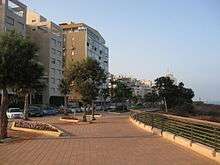
The city currently has a modest but growing skyline, with several of the tallest buildings in Israel located there. In 2011, it was announced that eight new skyscrapers, six of them over 30 stories, would be built in the city. It was also reported that in the coming years, the city's skyline will alter as dozens of 40–42-story skyscrapers will be built, many of them along the shore.[44][45]
Currently, there are plans to make Netanya a major tourist hub, both to Israelis and European tourists, by turning the city's coastline into an "Israeli Riviera", with multiple development projects planned for the city's shore.[46] Among the projects planned is the clearing of a landfill containing 2.5 million cubic meters of waste, and redeveloping the area into a residential and hotel area of 2,062 housing units and 1,100 hotel rooms. Most of the area will be left as open space, as part of the city's goal to go from 56 to 70 percent open space. The plan is expected to attract more residents to the city, expand hotel development, and increase the iris reserve areas, as well as the number of gardens, and green spaces.[47]
International relations
Twin towns – sister cities













Notable residents
- Linor Abargil, Miss Israel World 1998, Miss World 1998
- Yityish Titi Aynaw, Miss Israel 2013
- Orit Bar-On (born 1975), Olympic judoka
- Yehuda Barkan, actor and filmmaker
- Edith Hahn Beer, Austrian Jewish woman who survived the Holocaust by hiding her Jewish identity and marrying a Nazi officer
- Cheryl Bentov, American real estate agent and former Israeli Mossad agent
- Noah Brosch, astronomer, astrophysicist and space researcher
- Yonatan "Yoni" Chetboun, member of the Knesset
- Jacko Eisenberg, singer
- Eli Finish, actor and comedian
- Yarden Gerbi (born 1989), world champion and Olympic bronze medalist judoka
- Haim Gidon, martial artist
- Moshe Glam, football player
- Ageze Guadie (born 1989), Olympic marathon runner
- Nadav Guedj, Israeli 2015 Eurovision Song Contest entrant
- Yekusiel Yehudah Halberstam, Klausenburger Rebbe
- Zvi Elimelech Halberstam, Sanzer Rebbe
- Yitzhak "Haki" Harel, civil servant and army general
- Mariano Idelman, actor and comedian
- Silvi Jan, female professional and Israeli team footballer
- Baruch Kimmerling, scholar and professor of sociology
- Moti Kirschenbaum, television presenter and filmmaker
- Aliza Lavie, academic and politician
- Ronny Levy, football player and now a manager
- Imi Lichtenfeld, martial artist, founded Krav Maga
- Nili Lotan, Israeli-American fashion designer
- Oded Machnes, football player
- Tesama Moogas, Olympic marathon runner
- Sagi Muki, reigning European judo champion
- Andrea Murez, Israeli–American Olympic swimmer for Israel
- Or Sasson, Olympic bronze medalist judoka
- Stav Shaffir, activist, journalist, and politician
- Arik Shivek, basketball coach
- Mordechai Spiegler, football player
- Shiraz Tal, model
- Shalom Tikva, football player
- Margalit Tzan'ani, singer
- Meir Wieseltier, poet
- Ehud Yatom, Shin Bet agent and Knesset member
- Ron Yosef (b. 1974), openly gay Orthodox Jewish rabbi
References
- 1 2 "List of localities, in Alphabetical order" (PDF). Israel Central Bureau of Statistics. Retrieved August 26, 2018.
- 1 2 3 4 5 6 7 8 9 "History". Retrieved April 6, 2008.
- ↑ Benton, William (1974). The New Encyclopædia Britannica. 7. Encyclopædia Britannica (UK) Ltd. p. 270. ISBN 0-85229-290-2.
- 1 2 Teller, Hanoch (1996). A Midrash and a Maaseh. NYC Publishing Co. p. 349. ISBN 1-881939-09-X.
- ↑ "Nathan Straus". Encyclopaedia Britainnica Online. 2012. Retrieved February 7, 2012.
- 1 2 "Nathan Straus (1848–1931)". Jewish Virtual Library. 2012. Retrieved February 7, 2012.
- ↑ Wigoder, Geoffrey (1975). Everyman's Judaica: An encyclopedic dictionary. W.H. Allen / Virgin Books. p. 574. ISBN 0-491-01604-2.
- ↑
- ↑ Yacobi Haim (2009). The Jewish-Arab city: spatio-politics in a mixed community.
- ↑ Bell, Bowyer J.: Terror out of Zion (1976)
- 1 2 3 OECD: Spatial Planning and Policy in Israel The Cases of Netanya and Umm al-Fahm
- ↑ "Archived copy". Archived from the original on August 26, 2017. Retrieved August 26, 2017.
- ↑ "Archived copy". Archived from the original on August 26, 2017. Retrieved August 26, 2017.
- ↑ Jodi Rudoren,'Remaking a Life, After Years in an Israeli Prison,' New York Times March 29, 2014.
- ↑ Isabel Kershner, 'Israeli Tactics Thwart Attacks, With Trade-Off,' New York Times, May 3, 2008.
- ↑ http://www.ynetnews.com/articles/0,7340,L-4686286,00.html
- 1 2 "Population Density". Archived from the original on November 24, 2007. Retrieved April 6, 2008.
- ↑ http://www.netanya.muni.il/Eng/?CategoryID=1598&ArticleID=2392
- ↑ "Origins". Retrieved April 6, 2008.
- ↑ "Press Release – The Ethiopian Community in Israel" (PDF) (in Hebrew). Israel Central Bureau of Statistics. November 15, 2009. Retrieved December 18, 2010.
- ↑ Yoder, Christi (10 June 2015). "Saving Israel's Coastal Iris". blog.enketo.org. Retrieved 26 April 2016.
- ↑ "The Irises Dora Rainpool nature park". flowersinisrael.com. Retrieved 1 May 2016.
- ↑ "About Us". Lev Lalev. Retrieved December 30, 2010.
- ↑ "A Historical Perspective of Laniado Hospital". American Friends of Laniado Hospital. Archived from the original on July 27, 2011. Retrieved February 19, 2011.
- ↑ Lifschitz, Judah (2007). The Klausenberger Rebbe: Rebuilding. Targum Press. p. 175. ISBN 978-1-56871-451-6.
- ↑ Tannenbaum, Rabbi Gershon (December 12, 2007). "Sanz-Klausenberger Rebbe's Anticipated Visit". The Jewish Press. Retrieved December 25, 2010.
- 1 2 "Netanya Real Estate". Luxury Israel Real Estate. Archived from the original on November 10, 2010. Retrieved December 30, 2010.
- ↑ Leibowitz Schmidt, Shira (May 4, 2006). "Rebuilding is Remembrance". The Jerusalem Post. Retrieved December 30, 2010.
- ↑ Tessler, Rudolph (1999). Letter to mMy Children: From Romania to America via Auschwitz. University of Missouri Press. p. 204. ISBN 0-8262-1244-1.
- ↑ "Kiryat Sanz". Kiryat Sanz & Institutions. Archived from the original on July 21, 2011. Retrieved December 30, 2010.
- ↑ "About the Hospital". British Friends of Laniado Hospital. Archived from the original on November 12, 2010. Retrieved December 28, 2010.
- 1 2 "The official website of Shay Li service taxis with routes and timetables". Archived from the original on December 18, 2008. Retrieved November 21, 2008.
- ↑ "Israel Railways' schedule". Israel Railways. Archived from the original on August 22, 2008. Retrieved November 19, 2008.
- ↑ "Museums and Galleries". Retrieved April 7, 2008.
- ↑ "Netanya the last stop for Holocaust train car". January 26, 2014. Retrieved April 29, 2014.
- ↑ "The site of the Memorial p. 10" (PDF). Retrieved April 29, 2014.
- ↑ "Israel names street after diplomat Sugihara, who issued 'visas for life' to Jews during WWII". japantimes.co.jp. The Japan Times. June 8, 2016. Retrieved June 8, 2016.
A ceremony on a planned street named after the late Japanese diplomat Chiune Sugihara was held in Netanya, Israel, on Tuesday. Sugihara issued transit visas to thousands of Jewish people during World War II, which later came to be known as “visas for life,” as they saved many from Nazi persecution. Netanya is known as a place where many Jewish people arrived after fleeing from the oppression thanks to visas issued by Sugihara. The plan to build the street marks 30 years since Sugihara’s death. “It’s such an honor. I wish my father was here,” said Sugihara’s fourth son, Nobuki, 67.
- ↑ "Education". Retrieved April 6, 2008.
- ↑ "Higher Education". Retrieved April 7, 2008.
- ↑ "Imi Lichtenfeld". Retrieved October 28, 2014.
- ↑ "Archived copy". Archived from the original on April 2, 2015. Retrieved March 18, 2015.
- ↑ http://www.swimmersdaily.com/2014/08/04/len-moves-2015-short-course-europeans-to-december/
- ↑ "Israel to Host 2018 FIL Men's Lacrosse World Championship" (Press release). Federation of International Lacrosse. 23 May 2017.
- ↑ "mynet נתניה – קפיצה לגובה: שמונה גורדי שחקים יוקמו בנתניה". Mynet.co.il. Retrieved March 26, 2013.
- ↑ "לוח דירות להשכרה, למכירה, רכב, יד שניה, דרושים – WinWin". Archived from the original on March 19, 2013. Retrieved October 28, 2014.
- ↑ "Netanya mayor dreams of Israeli Riviera – Israel Business, Ynetnews". Ynetnews.com. June 20, 1995. Retrieved March 12, 2013.
- ↑ Udasin, Sharon. "Netanya landfill to be developed into housing units | JPost | Israel News". JPost. Retrieved March 26, 2013.
- ↑ "Netanya – Twin Cities". Netanya Municipality. Archived from the original on February 1, 2013. Retrieved August 1, 2013.
- ↑ "Dorset Twinning Association List". The Dorset Twinning Association. Archived from the original on June 21, 2012. Retrieved August 1, 2013.
- ↑ Zarzour, Kim. "Richmond Hill twins with Israeli city of Netanya". YorkRegion.com. Metroland Media Group. Retrieved 4 December 2016.
- ↑ "List of Twin Towns in the Ruhr District" (PDF). Archived from the original (PDF) on November 28, 2009.
- ↑ "Gießen: Städtepartnerschaften" [Giessen: Twin towns] (in German). Stadt Gießen. Archived from the original on April 13, 2013. Retrieved August 1, 2013.
- ↑ "Villes jumelées avec la Ville de Nice" (in French). Ville de Nice. Archived from the original on October 29, 2012. Retrieved June 24, 2013.
- ↑ "Miasta partnerskie i zaprzyjaźnione Nowego Sącza". Urząd Miasta Nowego Sącza (in Polish). Archived from the original on May 23, 2013. Retrieved August 1, 2013.
External links
| Wikimedia Commons has media related to Netanya. |
| Wikivoyage has a travel guide for Netanya. |
- Official website (in Hebrew)
- Official website
- Things to do in Netanya
- Places To Visit in Netanya
- Official tourism website
- Other information, in French
- Tourism site
- Surfing in Netanya
- Tandem Paragliding Netanya



